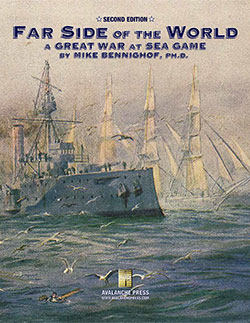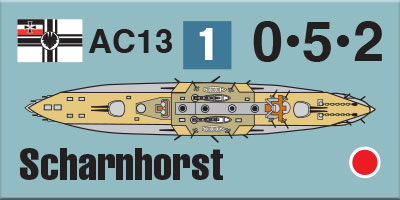Far Side of the World:
The Ships, Part One
by Mike Bennighof, Ph.D.
April 2025
 Great War at Sea: Far Side of the World marks another radical re-construction as we bring the Great War at Sea series back to its proper prominence. The game takes the topic and the map from our old Cruiser Warfare game, but otherwise its completely new: rules, scenariosm play aids and most of all the set of 300 die-cut, silky-smooth playing pieces. All of them with nrand-new, crisp artwork. That lets us add even more options and scenarios than we had in the old game. Great War at Sea: Far Side of the World marks another radical re-construction as we bring the Great War at Sea series back to its proper prominence. The game takes the topic and the map from our old Cruiser Warfare game, but otherwise its completely new: rules, scenariosm play aids and most of all the set of 300 die-cut, silky-smooth playing pieces. All of them with nrand-new, crisp artwork. That lets us add even more options and scenarios than we had in the old game.
The process we use now, to produce those fine die-cut and silky-smooth pieces (the envy of the known universe!) also gives us very sharp reproduction and rich colors. That means that the old ship artwork wasn’t usable any more: it just was not good enough. So even if a ship appeared in the old game, it has a new drawing, and often it ratings have been updated, too. And a bunch of ships that once appeared in silhouette form on smaller, square pieces, now have lovely top-down drawings on double-sized pieces. Let’s start a look at some of them.
The Americans

The U.S. Navy had no presence in the old Cruiser Warfare, which limited some of the potential options in that game. Now we have both American forces: the Asiatic Fleet, stationed in the Philippines, and the Pacific Fleet, based on the U.S. West Coast.
The Pacific Fleet was built around the six big armored cruisers of the Pennsylvania class. Five of the six still retained their “state” names in August 1914, but would eventually give them up to new battleships. In Far Side of the World they’re named as things stood at the outbreak of war. The lead ship, Pennsylvania, had been re-named Pittsburgh in August 1912 and that’s the name she carries in the game.
These are the ships armed with 8-inch guns; their near-sisters armed with 10-inch guns were all part of the Atlantic Fleet in August 1914 (though some had done tours in the Pacific in prior years). These were big cruisers, the size of a contemporary pre-dreadnought battleship, and the U.S. Navy’s preferred means of power projection and flag-display. At the start of the war, four of the cruisers formed the active squadron, with the other two in reserve at Bremerton, Washington.

The small Asiatic Fleet counted just one capital ship, the armored cruiser Saratoga, the former New York. She had been thoroughly modernized between 1905 and 1909, receiving new completely armament (the same twin 8-inch turrets as the Pennsylvania class), new engines and improved protection. It was an expensive rebuild, just in time for the new British battle cruisers to render her thoroughly obsolete. That made her the perfect candidate for the Navy’s most isolated station.
The British

The Royal Navy bore the burden of hunting down Maximilian von Spee’s German East Asia Cruiser Squadron, and that means that the British have more ships in Far Side of the World than anyone else. While there are a handful of modern ships, like the powerful battle cruiser Princess Royal, most British ships are rather elderly and unsuited for the North Sea theater: pre-dreadnought battleships, armored cruisers and the unsung workhorses of trade protection, the vast collection of elderly protected cruisers that patrolled the world’s oceans.

Three small, elderly cruisers that appeared on small, square pieces in the old Cruiser Warfare have been upgraded to the beautiful long pieces with top-down drawings. Many of the other British ships (mostly armored and protected cruisers) have had their ratings revised to bring them in line with more recent Great War at Sea games.

And all of the artwork is new. The Royal Navy deserved no less.
The Australians

Alongside the Royal Navy, the small Australian squadron also hunted for the German cruiser squadron. But the young Commonwealth provided the most powerful ship in the Pacific, at least unti the Japanese joined the war, in the form of the battle cruiser Australia. Australia supposedly had the firepower to sink the entire German squadron by herself (you can try this out in the game; it’s kind of a stretch). But she is a powerful, modern fast ship, accompanied by a pair of modern light cruisers.
The Canadians
While Australia had embraced the British Admiralty’s plan for all of the Dominions to provide a cruiser squadron for the Royal Navy, the Canadians bickered over whether they should build just cruisers or provide a division of dreadnoughts, and if so, where they should be built. As a result, they did neither.

But they did acquire two aging cruisers for training purposes, and in August 1914 these sallied forth to seek out German warships. Fortunately for their crews, they did not find Spee’s cruisers. But we have them in the game!
The Japanese

After the Royal Navy, the largest fleet in Far Side of the World belongs to the Imperial Japanese Navy. The Japanese have the strength to wipe out Spee’s squadron, but they’ll only send a few ships far from home waters. Those few ships are enough to pose a danger to the Germans, though.

For the new game, the Japanese have received a serious upgrade, with new artwork on their existing ships (badly needed for some) and ten ships formerly placed on small pieces given the full-scale treatment of a “long” piece.

If the Central Powers player is wise, he or she will keep away from the Japanese. But we have a scenario/history book, East Indies Campaigns, that lets you get full use out of the Emperor’s fleet in a Great War-era Strike South campaign into the Dutch East Indies.
The Germans

There’s no game without the German squadron, and like the others they’ve had a major artwork upgrade and some revisions to their game ratings. But we’ve also added more Germans, because that allows more game options, and that means more ways to play your game and have more fun while you’re doing it.

They have the armored cruiser Blücher, which out-classes any of the British armored cruisers hunting for Spee and could have been sent out to the China Station (though she had a vital peacetime role at home as gunnery training ship and testbed for new range-finding gear). The battle cruiser Moltke, which scouting forces commander Franz Hipper suggested sending into the Atlantic to disrupt British deployments and provide a distraction to aid Spee. Her sister ship Goeben and consort Breslau; rampaging through the Mediterranean, the British also had to account for the possibility of their exiting into the Atlantic (and so the Allied player must do so as well).

And finally, the Germans get two dreadnoughts, which hurried home from a South American goodwill and training cruise just before the outbreak of war. A little delay, and they could have been caught far from home, with a deep hunger for coal and immense firepower compared to the pre-dreadnoughts and armored cruisers the British have available to hunt them.

Far Side of the World comes in our Playbook format: everything you need to play (except dice), all inside a book. It’s a complete Great War at Sea game, and a unique one that you mostly already know how to play.
Order Far Side of the World right here.
Please allow an extra three weeks for delivery.
Sign up for our newsletter right here. Your info will never be sold or transferred; we'll just use it to update you on new games and new offers.
Mike Bennighof is president of Avalanche Press and holds a doctorate in history from Emory University. A Fulbright Scholar and NASA Journalist in Space finalist, he has published a great many books, games and articles on historical subjects; people are saying that some of them are actually good.
He lives in Birmingham, Alabama with his wife and three children. He misses his lizard-hunting Iron Dog, Leopold.
Daily Content includes no AI-generated content or third-party ads. We work hard to keep it that way, and that’s a lot of work. You can help us keep things that way with your gift through this link right here.
|
